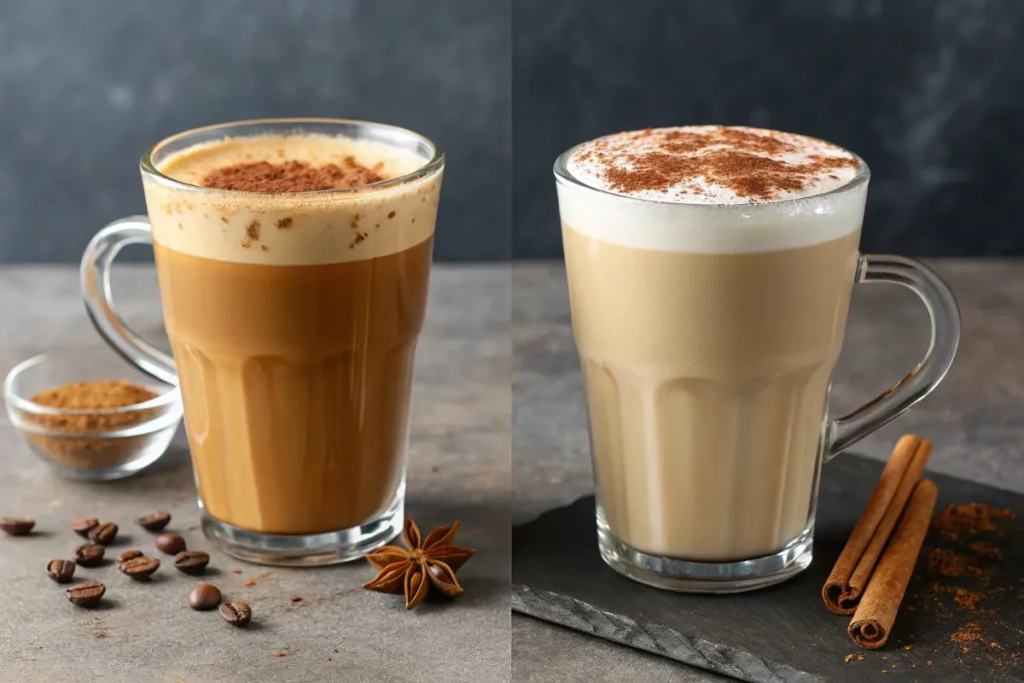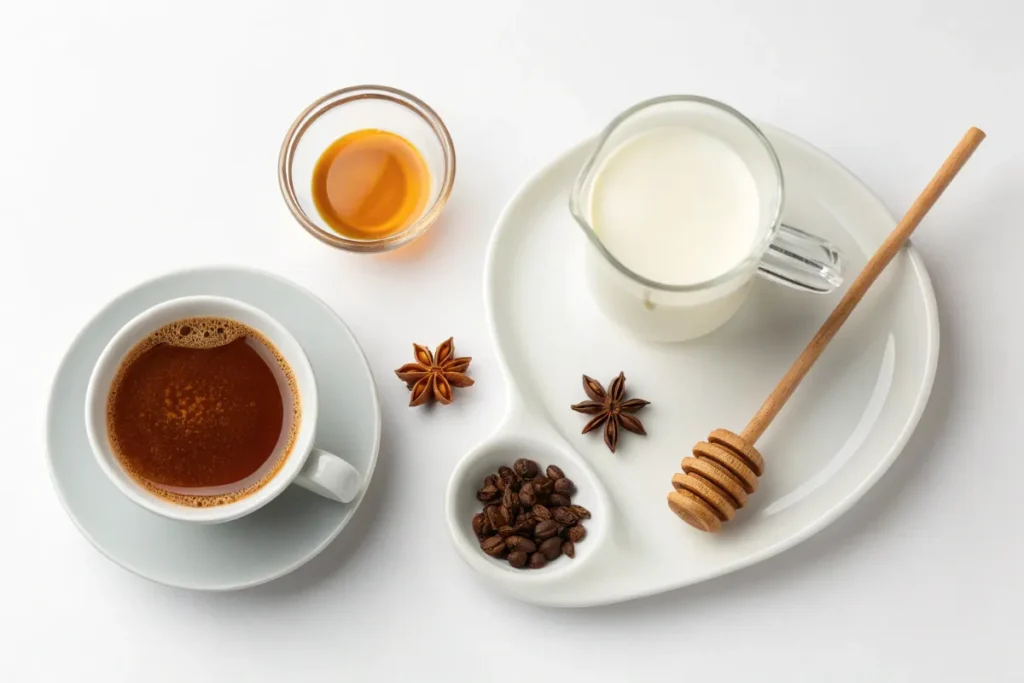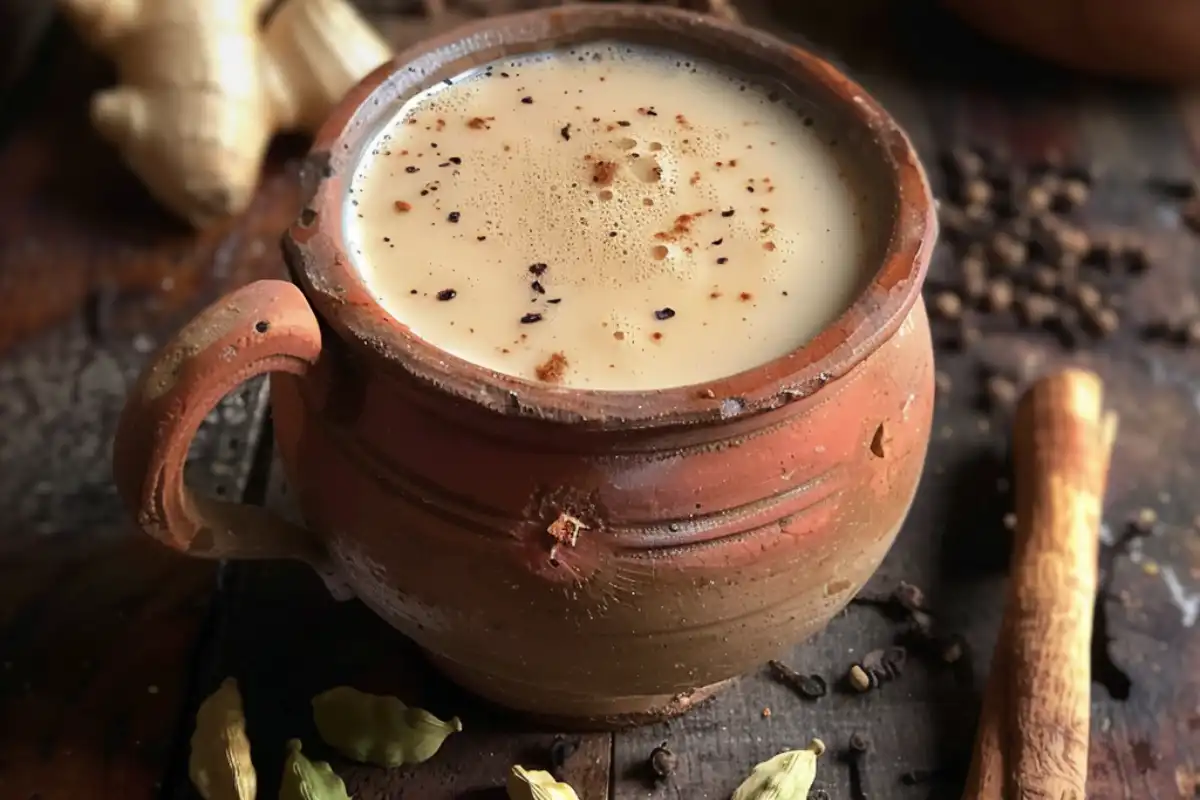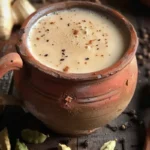Dirty chai has steadily gained popularity over the years, becoming a must-try beverage for anyone who enjoys the fusion of bold coffee flavors with the aromatic spices of chai. But what exactly is dirty chai? How does it differ from traditional chai, and why has it captured the hearts of coffee and tea lovers alike?
This guide will explore everything there is to know about this tea. From its origins to how to make it at home, we’ll cover all the essential details. Whether you’re a chai enthusiast or a coffee lover looking for a new twist, this article will help you understand why this tea is the perfect fusion of two beloved beverages.
Table of Contents
The Origins of Dirty Chai
Unlike traditional masala chai, which dates back thousands of years in India, dirty chai is a modern fusion drink. Legend says it was created accidentally when a barista added espresso to a chai latte, and the customer loved it. It soon gained popularity as a “secret menu” item in coffee shops across Europe and North America and is now a staple at major chains and independent cafés worldwide.
Dirty Chai vs. Chai Latte: What’s the Difference?

At first glance, dirty chai may look similar to a chai latte, but the two drinks differ significantly in their ingredients and flavor profiles.
Chai Latte
- A chai latte is simply a blend of chai tea and steamed milk. It uses masala chai, a traditional Indian spiced tea that typically includes spices like cinnamon, cardamom, cloves, and ginger.
- The result is a warm, spiced drink that’s sweet, creamy, and perfect for those who enjoy a lightly spiced beverage without the boldness of coffee.
Dirty Chai
- A dirty chai, on the other hand, includes an added shot of espresso, giving it a stronger flavor and a higher caffeine content.
- This combination of chai and coffee makes this tea more intense, with both the aromatic spices and the rich coffee flavor standing out.
Ingredients of Dirty Chai

Let’s break down the key components of a dirty chai and understand what each ingredient brings to the table.
1. Masala Chai (Spiced Black Tea)
At the heart of any dirty chai is masala chai, a spiced black tea. Traditionally brewed with a combination of warming spices, masala chai is what gives the drink its aromatic and spicy undertones.
- Cinnamon: Adds warmth and sweetness to the drink.
- Cardamom: Provides a floral, citrusy note.
- Cloves: Adds depth and a slight bitterness.
- Ginger: Provides a zesty, spicy kick.
2. Espresso Shot
The addition of an espresso shot is what transforms a chai latte into a dirty chai. Espresso brings a rich, intense coffee flavor that cuts through the sweetness of the tea and spices.
- A single shot of espresso contains approximately 63 mg of caffeine, adding to the caffeine content of the drink.
- Some people prefer to add a double shot for a bolder flavor, creating what is known as a double dirty chai.
3. Steamed Milk or Alternatives
Steamed milk gives the drink its creamy texture. You can choose from a variety of milk options, including:
- Whole milk: Adds richness and creaminess.
- Oat milk: A popular plant-based alternative with a naturally sweet, creamy texture.
- Almond milk: Adds a nutty flavor and is a lower-calorie option.
- Soy milk: A versatile plant-based option with a neutral flavor.
4. Sweeteners and Syrups
While masala chai is flavorful on its own, many people like to add sweeteners to their tea. Common options include:
- Sugar: The most traditional sweetener.
- Honey: Adds a natural sweetness and works well with the spices.
- Flavored syrups: Syrups like vanilla, caramel, or hazelnut can be used to enhance the flavor of the drink.
For a homemade sweetening option, consider making your own chai syrup. You can find more details on how to do this in our guide on making chai syrup at home.
How to Make Dirty Chai at Home
Making this tea at home is easier than you might think. With just a few ingredients, you can recreate this coffeehouse favorite in your own kitchen.
Ingredients:
- 1 chai tea bag or 1 teaspoon of loose-leaf chai
- 1 shot of espresso (or 2 shots for a stronger flavor)
- 1 cup of steamed milk or a milk alternative
- Sweetener of your choice (optional)
- Ground cinnamon or nutmeg for garnish
Instructions:
- Brew the chai tea: Steep your chai tea in hot water for about 5 minutes. If using loose-leaf tea, strain the tea before proceeding.
- Prepare the espresso: Brew a fresh shot of espresso using an espresso machine or stovetop espresso maker.
- Steam the milk: Heat your milk until it’s hot but not boiling. You can use a milk frother to create a nice, frothy texture.
- Combine: In a mug, combine the brewed chai tea, espresso, and steamed milk. Stir well.
- Garnish and sweeten: Add a dash of ground cinnamon or nutmeg on top for extra flavor, and sweeten to taste with honey or syrup if desired.
Dirty Chai Variations
One of the great things about this tea is that it can be customized to suit your personal taste. Here are a few popular variations:
- Iced Dirty Chai – Served over ice with cold milk for a refreshing twist on the classic.
- Vegan Dirty Chai – Swap dairy milk for almond, soy, oat, or coconut milk for a plant-based option.
- Double Dirty Chai – Add two espresso shots for a bolder, more caffeinated kick.
If you’re a fan of spiced seasonal treats, you might enjoy pairing your tea with Gingerbread Latte Cookies that perfectly complement the warm and spicy notes of your chai.
Caffeine Content in Dirty Chai
Since this tea contains both black tea and espresso, it has a higher caffeine content than a traditional chai latte. On average, a 12-ounce dirty chai contains about 160 mg of caffeine, though this can vary depending on the size of the drink and whether you add extra espresso shots.
For comparison, a regular chai latte usually contains between 50-70 mg of caffeine, while a standard shot of espresso has about 63 mg. This means that this tea can provide a substantial energy boost, making it a great choice for those who need an extra kick.
For those who enjoy experimenting with plant-based lattes, you might also be interested in trying floral-infused drinks like a Lavender Oatmilk Latte.
Dirty chai offers a unique blend of flavors that combines the warmth of chai tea with the boldness of espresso. Whether you prefer it hot, iced, or with a plant-based twist, this tea is a drink that’s easy to customize and enjoy. Its balance of spice and coffee makes it a perfect beverage for any time of day.
If you’re new to this chai, give it a try at your favorite coffee shop, or make your own at home using our recipe. Don’t be afraid to experiment with different types of milk, sweeteners, and syrups to find your perfect blend.
FAQs
1. What makes a chai dirty?
- A chai becomes “dirty” when a shot of espresso is added to the chai tea, giving the drink a richer, more complex flavor.
2. How much caffeine is in a dirty chai?
- A typical 12-ounce dirty chai contains about 160 mg of caffeine, due to the combination of black tea and espresso.
3. Can I make a dirty chai with decaf espresso?
- Yes! You can easily substitute decaf espresso for regular espresso to reduce the caffeine content while still enjoying the flavors of this tea.
4. Is dirty chai available at most coffee shops?
- Most coffee shops, will make this tea on request, even if it’s not listed on the menu. Just ask for a chai latte with an added shot of espresso.
Dirty Chai
This Dirty Chai is a bold and flavorful blend of spiced chai tea and rich espresso, creating the perfect balance of warmth and energy. Whether hot or iced, this creamy, spiced latte is a coffeehouse favorite you can make at home! ☕
- Prep Time: 5 minutes
- Cook Time: 10 minutes
- Total Time: 15 minutes
- Category: Drinks
- Method: Stovetop
- Cuisine: Indian
Ingredients
For the Dirty Chai:
- 2 cups water
- 1 cinnamon stick
- 3 green cardamom pods, crushed
- 3 cloves
- 1-inch piece fresh ginger, sliced
- ½ tsp black peppercorns
- ½ tsp ground nutmeg
- 1 star anise (optional)
- 2 black tea bags (or 2 tsp loose-leaf black tea)
- 1 cup milk (or dairy-free alternative)
- 2 shots espresso (or ½ cup strong brewed coffee)
- 2 tbsp honey or maple syrup (adjust to taste)
- ½ tsp vanilla extract (optional)
Instructions
-
Simmer the Spices:
- In a saucepan, combine water, cinnamon, cardamom, cloves, ginger, black pepper, nutmeg, and star anise.
- Bring to a boil, then reduce heat and let simmer for 5 minutes to infuse the flavors.
-
Brew the Tea:
- Add black tea bags and steep for 3-5 minutes, depending on desired strength.
-
Add Milk & Espresso:
- Stir in milk and warm gently.
- Add espresso shots and mix well.
-
Sweeten & Strain:
- Remove from heat and strain the chai mixture into mugs.
- Stir in honey or maple syrup and vanilla extract if using.
-
Serve & Enjoy:
- For a frothy latte, use a milk frother before pouring.
- Serve hot or over ice for an iced dirty chai!
Notes
- For an extra caffeine boost, add an additional shot of espresso.
- For a spicier kick, increase black pepper or add a pinch of cayenne pepper.
- For a dairy-free version, use oat milk, almond milk, or coconut milk.


